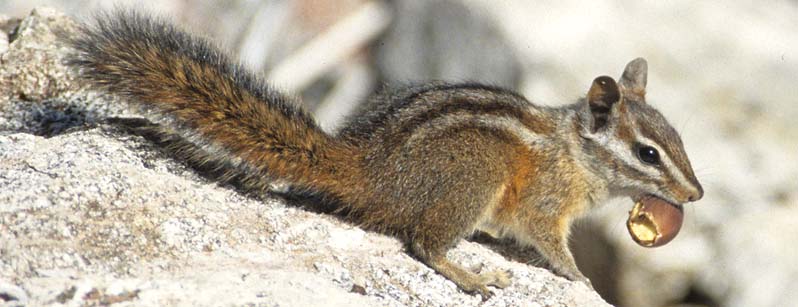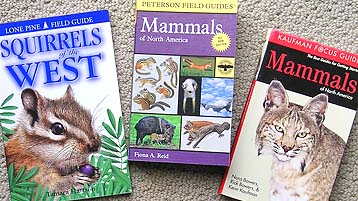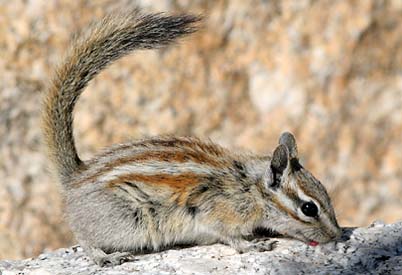|
||||
 |
||||
In most places there is only one species of chipmunk, so a starting point for anyone is to learn their local species. Where I live in Monterey Co., California, the only species is Merriam's Chipmunk (above & right). It is a darkish chipmunk with a pattern of blackish and light gray stripes, and a dark tail without whitish. Some other chipmunks have crisper black-and-white striped patterns, including the one and only species in Asia, Siberian Chipmunk (below).
|
||||
My local species — Merriam's Chipmunk — ranges through the foothills of central and southern California. It particularly like chaparral areas and scurries around on branches and logs. It has a loud, fast alarm call; a series is fast chips. When it stops, it sways its tail slowly (Reid 2006). Body color, voice, behavior, and habitat all help to identify chipmunks, but range is most important. There are no "vagrant" chipmunks. You must know what chipmunk is in range to make an identification.
|
||||
|
||||
| As a birder, I put off learning chipmunks for a long time. I had a job in college skinning birds and mammals for the taxidermy collection at my small rural school. When I was taught to skin chipmunks and squirrels I learned that one must look for and locate the bacula — the penis bone — on all males, and tie it to the label on the specimen. It sounded very weird to me at the time, and it still sounds pretty strange today (and no, I'm not making this up). Indeed, if you read Ingles (1965) seminal book on Pacific coast mammals he has a whole appendix on "technique for preparing and preserving bacula" and a page of drawings comparing the bacula of chipmunks. Believe me, it is pretty hard to look for the bacula of chipmunks in the field! [... and in some species the female genital bones — baubellum — are also distinctive.] | ||||
|
||||
According to Johnson (1943) there can be more variation in the coloration of a single chipmunk over the course of a year that there is between species. The pelage can be different in summer than in winter. Sutton (1962) showed differences in chromosomes and some taxonomic changes have been adopted largely on genetic grounds. All of these points make for discouraging reading when thinking about field identification in the 1990s. Now, however, authors using criteria developed in birding, and these have helped to sort out many of the problems. I have photos of a few species that we can use to compare. Let's start in open habitats: at high elevation or in scrub, and away from the dense forests, with Least Chipmunk (below left) and Alpine Chipmunk (below right). |
||||
|
||||
Least Chipmunk (above left) is the common small chipmunk of sagebrush below the pinyon/juniper zone. The range extends across the entire Great Basin (it also occurs across much of Canada, and we compared it to Eastern Chipmunk above). Because of its wide range and variety of habitats it is the most variable of all chipmunks, but it is also the smallest and has very short ears. It is said that where its range overlaps other species it is dominated by larger chipmunks and therefore restricted to sage and brush habitats. It has much gray to the shoulders and rump, and the striping pattern is sharp. It often runs with its slim tail held straight up. Its tail is essentially as long as the rest of its body. Alpine Chipmunk (above right) is also small, rather like the Least, but has less distinct stripes (not nearly so black-and-white), has a shorter tail (not as long as its body), and has longer and more pointed ears. It does have a distinct outer stripe on the body and essentially lacks the orangeish sides of Lodgepole Chipmunk (instead, the stripes themselves can be orangey-brown, as on this individual). [Uinta Chipmunk T. umbrinus of the eastern Sierra and isolated Great Basin mountains lacks the dark outer stripe but has subdued orangeish sides.] Alpine Chipmunk is usually found above 8,000' elevation, or even above 9,000' in the Yosemite Sierra (Ingles 1965, Harris 1982). It likes talus slopes or meadows at or above timberline. Like all chipmunks that live where it snows in winter, these species hibernate underground. Least, like most chipmunks, does not put on a layer of fat to hibernate, so it will awake on sunny winter days to forage from seeds. Alpine does put on a layer of fat, and thus sleeps from mid-autumn well into spring (Hartson 1999). |
||||
| Now let's compare two more colorful chipmunks of Sierran forests: Yellow-pine (top and bottom left), and Lodgepole Chipmunk (bottom right): | ||||
|
||||
Both of these are small chipmunks, but not as tiny as Least or Alpine. The sides of both are rather bright orange, contrasting with the white outer body stripes, but there is no outer dark stripe on Lodgepole, whereas there is a dark outer border on Yellow-pine. Further, Yellow-pine has orange color up into the shoulder and lower part of the face, and even the lower facial stripe is orangeish-brown. The facial stripes of Lodgepole are crisply black-and-white. Both have a white patch behind the ear; both have gray atop the head and muzzle; and both have medium-length ears. The names — Yellow-pine and Lodgepole — describe the typical forest habitats of each species [e.g., Lodgepole is higher in elevation, in general], but both can occur in a broader range of habitats than their namesake woods. Yellow-pine Chipmunk has a wide range from southern British Columbia through northern California, and reaches its southern limit around Lake Tahoe. Here its range overlaps with Lodgepole, but the latter is almost entirely a California endemic, down the Sierra Nevada from Plumas County south to the Transverse Ranges of southern California. |
||||
Chipmunks are diurnal mammals and hibernate in cold weather. They have internal cheek patches for carrying food. Unlike most ground-squirrels which store fat for energy during dormant periods, chipmunks have large underground caches of food the the occasional periods of waking and for use in early spring in areas still covered by snow. Seeds and fruits constitute most of their diet although the Least Chipmunk eats a fair amount of insects and even lizards (Ingles (1965). Still, chipmunks are not easy to identify to species. One must consider range and habitat, of course, but also size, ear length, body color, pattern of stripes, and tail length and color. In some areas, vocalizations are important. Some of those issues are examined on the next page. |
||||
PHOTOS: The top photo of Merriam's Chipmunk Tamias merriami was at Cone Peak, Monterey Co., California, on 7 Oct 2003; the second shot was China Camp, Los Padres Nat'l Forest, Monterey Co., in April 1984. The Siberian Chipmunk T. sibiricus was at Oo, Buryatia, in SE Siberia, in July 1984. The Eastern Chipmunk Tamias striatus was at Mt. Hollyoak, Massachusetts, on 24 June 2007. The Least Chipmunk T. minimus was at Devils Tower Nat'l Monument, Wyoming, 15 June 1998. The Golden-mantled Ground-Squirrel Spermophilus lateralis was at Olmstead Pt., Yosemite Nat'l Park, 11 July 1981. The chipmunk in the shadows at Grant Grove, Kings Canyon Nat'l Park, in June 1997, is probably the Lodgepole Chipmunk T. speciosus. The Alpine Chipmunk T. alpinus was above Saddlebag Lake, Mono Co., California, on12 Aug 2009. The top Yellow-pine Chipmunk T. amoenus was at Taylor Creek, on the edge of Lake Tahoe, El Dorado Co., California, on 14 Aug 2006; the second Yellow-pine was at Willow Lake, Plumas Co., California, on 23 July 2007. The Lodgepole Chipmunk T. speciosus was at Devils Postpile Nat'l Monument, Madera Co., California, on 19 Aug 1998. All photos © Don Roberson, except that of Tamias sibiricus provided by Vladimir Dinets, used with his permission; all rights reserved. Literature cited:
|
| TOP Page created 7-23 June 2001, revised 5-6 July 2008 and revised again 18 Aug 2009 |
|
all
photos & text © 2008 Don Roberson
|
HOME |
 Chipmunks are small striped squirrels in the genus Tamias. Except for one species in northeast Asia, they are found only in North America. All chipmunks have facial stripes.
Chipmunks are small striped squirrels in the genus Tamias. Except for one species in northeast Asia, they are found only in North America. All chipmunks have facial stripes.
 Throughout most of eastern North America there is only one species: Eastern Chipmunk
(left). It inhabits forests, scrub, and suburban areas; makes elaborate
burrows; and hibernates in winter. It commonly visits bird feeders. It
has striking black-and-white side stripes but that they do not go
across the rump to the base of the tail. The only other species found
east of the Rockies — in the north woods east to Ontario and Michigan —
and also widely in the Great Basin, is Least Chipmunk
(below). It is grayish and very small. Its stripes go across the rump.
It has a proportionately longer tail than other species, and carries
its tail high when running.
Throughout most of eastern North America there is only one species: Eastern Chipmunk
(left). It inhabits forests, scrub, and suburban areas; makes elaborate
burrows; and hibernates in winter. It commonly visits bird feeders. It
has striking black-and-white side stripes but that they do not go
across the rump to the base of the tail. The only other species found
east of the Rockies — in the north woods east to Ontario and Michigan —
and also widely in the Great Basin, is Least Chipmunk
(below). It is grayish and very small. Its stripes go across the rump.
It has a proportionately longer tail than other species, and carries
its tail high when running. 


 It
is in the Sierra Nevada and Cascade mountain chains that chipmunks
become a major challenge, especially in California. In the central
Sierra, nine species are zonally distributed from Merriam's Chipmunk in
the foothill chaparral to Alpine Chipmunk T. alpinus in the talus slopes up near tree level to Panamint Chipmunk T. panamintinus
of pinyon-juniper woodlands east of the divide. Ingles (1965) explains
that chipmunks illustrate both the biological principle of Gloger's
Rule — mammal species are more heavily pigmented in more humid areas —
and that they have evolved patterns best suited to their habitat. Thus
Merriam's Chipmunk, which lives in dense chaparral where the shadows
are not sharply defined, has dingy stripes. Likewise Alpine Chipmunk,
which exists in open talus slopes, has poorly demarcated stripes. But
other species (Least, Lodgepole, Yellow-pine, Panamint chipmunks) that
"inhabit sunlit open forests where light-bathed twigs cast dark
shadows" have well-defined light and dark stripes. This character is
illustrated by this chipmunk (left) at the base of a huge Giant
Sequoia; note how bright the white stripes appear in the dappled light
of the understory. This photo may be inadequate for identification but
it does illustrate this principle.
It
is in the Sierra Nevada and Cascade mountain chains that chipmunks
become a major challenge, especially in California. In the central
Sierra, nine species are zonally distributed from Merriam's Chipmunk in
the foothill chaparral to Alpine Chipmunk T. alpinus in the talus slopes up near tree level to Panamint Chipmunk T. panamintinus
of pinyon-juniper woodlands east of the divide. Ingles (1965) explains
that chipmunks illustrate both the biological principle of Gloger's
Rule — mammal species are more heavily pigmented in more humid areas —
and that they have evolved patterns best suited to their habitat. Thus
Merriam's Chipmunk, which lives in dense chaparral where the shadows
are not sharply defined, has dingy stripes. Likewise Alpine Chipmunk,
which exists in open talus slopes, has poorly demarcated stripes. But
other species (Least, Lodgepole, Yellow-pine, Panamint chipmunks) that
"inhabit sunlit open forests where light-bathed twigs cast dark
shadows" have well-defined light and dark stripes. This character is
illustrated by this chipmunk (left) at the base of a huge Giant
Sequoia; note how bright the white stripes appear in the dappled light
of the understory. This photo may be inadequate for identification but
it does illustrate this principle.


